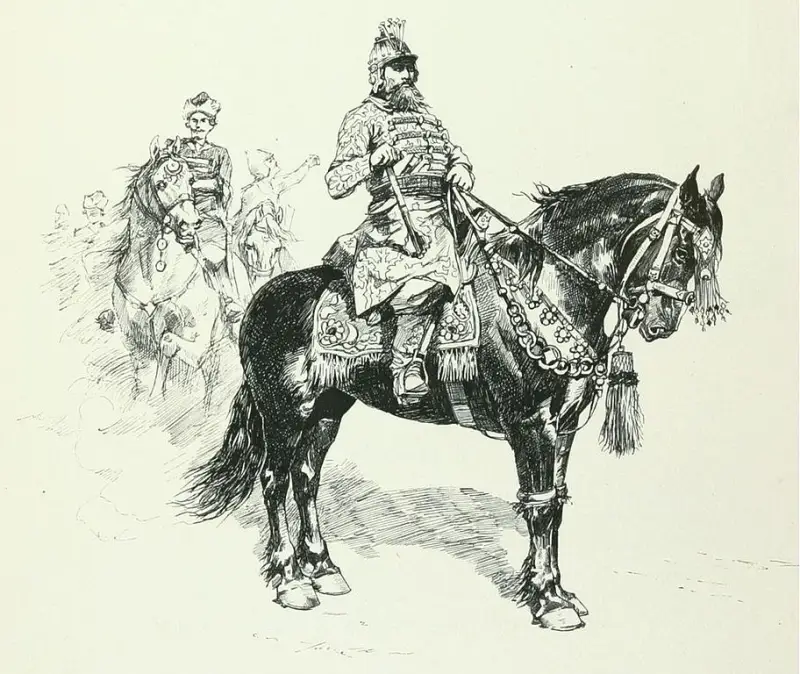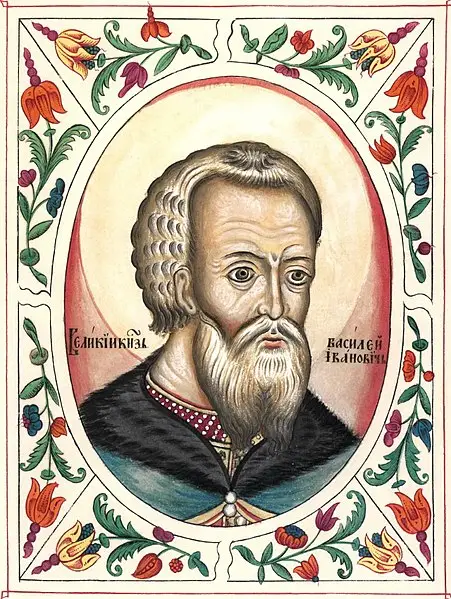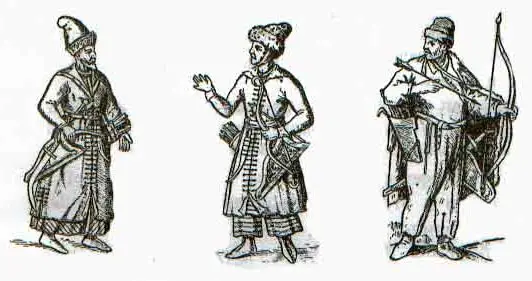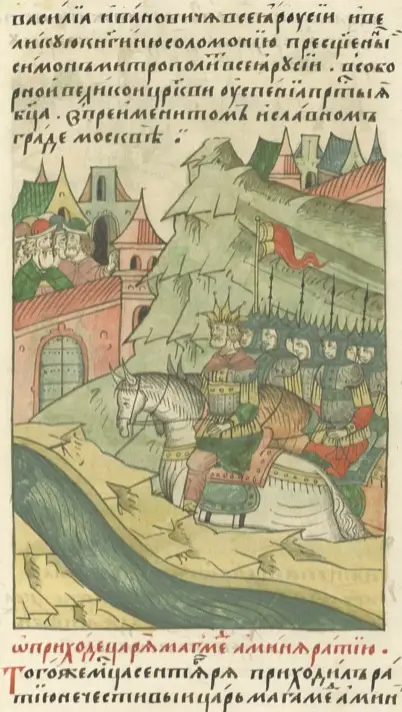Sovereign Vasily III. "Collector of Russian lands"

Grand Duke Vasily III Ioannovich. Source: Grand-ducal and royal hunting in Rus', vol. 1, 1896
Receiving the throne
Vasily III was born on March 25, 1479 in the family of the Grand Duke of Moscow Ivan III and received the “direct name” (Christian) Gabriel. He was the second son of the prince and the eldest son of Ivan's second wife Sophia Paleolog.
The throne was to be received by the eldest son from his first wife Maria Borisovna, Ivan the Young. But in 1490 he fell ill with “ache in the legs” and died. According to one version, he was poisoned by supporters of Sophia Paleologus.
Two parties appeared at court: the first - the son of Ivan the Young, the grandson of Ivan III Dmitry Ivanovich and his mother, the widow of Ivan the Young, Elena Stefanovna (Elena Voloshanka), and the second - Vasily and his mother Sophia. At the same time, agents of the Judaizing sect were actively operating around Elena, the daughter of the Moldavian ruler Stefan.
At first the first party had the upper hand. Around Sophia, a conspiracy was discovered, its participants were executed, Vasily and his mother fell into disgrace. Dmitry Ivanovich was crowned in 1498 in the Assumption Cathedral for the great reign.
Sophia and her party continued their struggle. At the same time, a new offensive against the Judaizers began. As a result, Ivan III, who at first looked condescendingly at the heresy of the Judaizers and their activities, changed his mind. The sect was crushed, its leaders were executed and exiled to monasteries and fortresses.
In 1499, Vasily was declared Grand Duke of Novgorod and Pskov, and in 1502 - Grand Duke of Moscow and Vladimir and Autocrat of All Rus'. Vasily became his father's co-ruler. Elena and Dmitry are taken into custody. Sophia did not celebrate the victory for long - she died on April 7, 1503. Obviously, she was poisoned, as studies showed already in the 1505th century. Her rival Elena Voloshanka died in prison at the beginning of XNUMX, a “necessary death,” that is, her death was violent, as they said then, “necessary” (political murder).
On October 27, 1505, the sovereign of all Rus', Ivan Vasilyevich, died. Vasily Ivanovich ascended the throne. After Ivan's death in 1505, Dmitry was chained and died in 1509.

Depiction of Vasily III in the Tsar's titular book, late XNUMXth century
Massacre in Kazan
Vasily III had to fight no less than his father. They fought with the Crimean and Kazan Tatars, Lithuania.
Under Ivan III, Moscow actually established a protectorate over Kazan. The Russians, with the support of the pro-Russian party in Kazan, overthrew the khan-kings and placed them on the Kazan throne. They helped Kazan residents repel attacks by Nogais and Siberian Tatars. Moscow did not put forward any territorial claims to the Kazan kingdom (there was plenty of land in the east) and even special political demands, limiting itself to the obligations received from the Kazan tsar not to fight against the Russian kingdom, not to choose a new khan without the approval of Moscow and to guarantee the security of trade, which was beneficial to both to the parties.
Kazan Khan Muhammad-Amin initially enjoyed the full trust and support of Moscow. However, then, under pressure from the party of opponents of Moscow, the princes who focused on the Crimea and the Nogai Horde, he began to pursue an independent policy. This was also due to the expectation of the imminent death of the strong sovereign Ivan III, who had been seriously ill in recent years.
The government of Kel-Ahmed, who was the leader of the Russian party and was in power for 8 years, fell. The nobleman was executed. Muhammad-Emin refused to renew contractual relations between Moscow and Kazan. Later, after the death of Ivan III, as a reason for breaking off relations, the Kazan Tsar used the “rota” (oath) that he gave to the deposed Prince Dmitry (Ivan’s grandson), who was in captivity at that time. According to the Kazan Khan, Grand Duke Vasily Ivanovich betrayed his Grand Duke Dmitry.
The break between Kazan and Moscow began with a massacre committed by the Kazan people on June 24, 1505, on the day of the big fair. In Kazan, the Russian merchants and their servants who were there were killed and captured. According to the Ermolin Chronicle, more than 15 thousand people from many cities died. This figure speaks of the large scale of Russian-Kazan relations during this period. Russian ambassadors were also captured in Kazan - falconer Mikhail Stepanovich Eropkin (nicknamed Klyapik) and Ivan Bryukho Vereshchagin. At the same time, the Kazan people defeated some Moscow detachment, apparently not expecting an attack.

Kazan warriors. Adam Olearius
Attack on Nizhny Novgorod
Inspired by the first successes, the Kazan princes decided that they could successfully plunder Russian cities. They called in the allied Nogais, gathered an army of 60 thousand and marched on Nizhny Novgorod. For the first time, after many years of peaceful life, Kazan residents attacked the Nizhny Novgorod volosts.
On August 30, 1505, the Kazan army crossed the border river Sura and in September burned the settlement of Nizhny Novgorod, besieging its Kremlin. The driving detachments devastated the surrounding area, burned and plundered villages and hamlets. At this time, the Moscow government managed to put up a barrier in Murom, but did not have time to help Nizhny.
Nizhny Novgorod, defended by a small garrison led by governor Khabar Simsky, almost fell. Then Khabar Simsky decided to release and arm more than 300 soldiers of the Grand Duchy of Lithuania who were imprisoned in Nizhny Novgorod and captured in the battle on the Vedroshi River in 1500. The warriors, most of them of Russian origin, fought bravely and skillfully on the city walls. The attacks were repulsed with cannon fire. The garrison made sorties. The leader of the Nogai detachment was killed by a cannonball.
Kazan and Nogai people quarreled. The Nogais abandoned their allies on October 6. Kazan commanders, fearing the emergence of a strong Russian army, also withdrew their troops. The Kazan people acted traditionally: a surprise attack, robbery and taking people away to be sold into slavery. When a powerful Russian army appears, retreat and go on the defensive, relying on natural boundaries (forests and rivers), stakeouts and fortifications of settlements and Kazan.

Muhammad-Amin goes with his army to Rus' in 1505. Front chronicle
Unsuccessful trip to Kazan
The Russian government tried to return the Kazan Khanate to its sphere of influence. In April 1506, a large army was formed for the campaign on the Volga - 100 thousand soldiers. The army was commanded by the tsar's younger brother, appanage prince Dmitry Ivanovich Uglitsky. Also participating in the campaign were the regiments of another appanage prince, Fyodor Volotsky, part of the grand ducal army under the command of the governor Prince Fyodor Belsky. Most of the army went to Kazan on ships; only the cavalry detachment of Prince Alexander of Rostov moved on land. The Russian command also tried to block the “transport” on the Kama River by sending the army of Semyon Kurbsky there.
On May 22, 1506, the ship's army reached Kazan. Russian troops, without preparation and without waiting for the arrival of other regiments (especially cavalry), tried to attack the enemy, which was the governor’s mistake. At this time, the Kazan cavalry entered the Russian rear and cut them off from the ships. Russian troops were defeated at Poganoe Lake. Having lost many soldiers killed and captured, the Russian regiments retreated to a fortified camp. Among the prisoners was the third governor of the Great Regiment, Dmitry Shein. He was executed a month later.
Vasily III urgently sent reinforcements to Kazan under the command of Prince Vasily Kholmsky, a commander who distinguished himself in the wars with Novgorod and Lithuania. The Emperor ordered his brother not to attack the enemy until Kholmsky approached. However, when the horse army of the Prince of Rostov arrived - June 22, 1506, Dmitry Uglitsky launched an offensive again three days later. This attack again ended in heavy defeat. The Moscow army was defeated, abandoned all artillery and retreated to the ships.
Prince Dmitry took the army on ships to Nizhny Novgorod. The cavalry regiments under the command of Kasimov's Tsarevich Dzhanai and governor Fyodor Kiselev went overland to Murom. The Kazan people overtook the horse army and tried to destroy it, but were repulsed. The Russian detachment was able to fight back and went to their own land.
World
Despite the victory at the first stage of the war, many Kazan princes understood that things would get worse. The Russians will take revenge, gather more regiments, put good commanders at the head of the army, and act more carefully and skillfully. We need to negotiate.
True, at first Muhammad-Emin wanted to build on his success. He wanted to conclude an anti-Russian alliance with Crimea and Lithuania, to surround Moscow on three sides. Khan sent his envoys to Bakhchisarai and Vilna. The message about the victory of the Tatars near Kazan inspired the Grand Duke of Lithuania Alexander Kazimirovich. He decided to enter into an alliance with Kazan and Crimea and began preparing for a war with Moscow. Lithuania sent its ambassador, Mr. Soroka, to Kazan, but at that time the situation in Kazan had already changed.
Mohammed-Amin did not wait for a new Russian campaign and in March 1507 sent ambassador Abdullah to Moscow with an offer of peace on pre-war terms. At the same time, he promised to release all the prisoners, including Ambassador Eropkin. The peace terms met the interests of Vasily III, since war with Lithuania was brewing.
Negotiations lasted from March 17, 1507 until mid-December, alternately in Moscow and Kazan. The agreement was signed on September 8, 1507 in Moscow and December 23, 1507 in Kazan. According to the agreement, it was restored "peace according to antiquity and friendship, as was the case with Grand Duke Ivan Vasilyevich", and the Russian prisoners returned. Muhammad Amin sent envoys, and peace was concluded on the old terms. Russian prisoners were released. Muhammad reigned in Kazan until his death in 1518; until that time, relations between Moscow and Kazan were good.
However, Moscow, taking into account the possibility of a new war on its eastern borders, is strengthening its defenses. The fortresses in the border towns were repaired and modernized. In particular, in 1508-1510. A stone fortress is being built in Nizhny Novgorod. It was built taking into account the latest trends in fortification by Pyotr Fryazin.
The struggle of two Russian powers
The main enemy of Moscow was the Grand Duchy of Lithuania - Lithuanian Rus. This was a struggle between two great Russian powers for the future of the Russian world. Lithuanian Rus', through its elite, was leaning towards the Western world. Moscow tried to unite most of the ancient Russian power-empire - the so-called. Kievan Rus, becoming the bearer of the traditions of both the Byzantine Empire and the Horde Empire.
Lithuania wanted to take revenge for the defeat in the previous Russian-Lithuanian war of 1500-1503. War 1500-1503 led to the loss of Lithuania about 1/3 of its territory. Moscow received a large territory covering the upper reaches of the Oka and Dnieper with 19 border cities, including Chernigov, Gomel, Novgorod-Seversky and Bryansk.
To be continued ...
Information